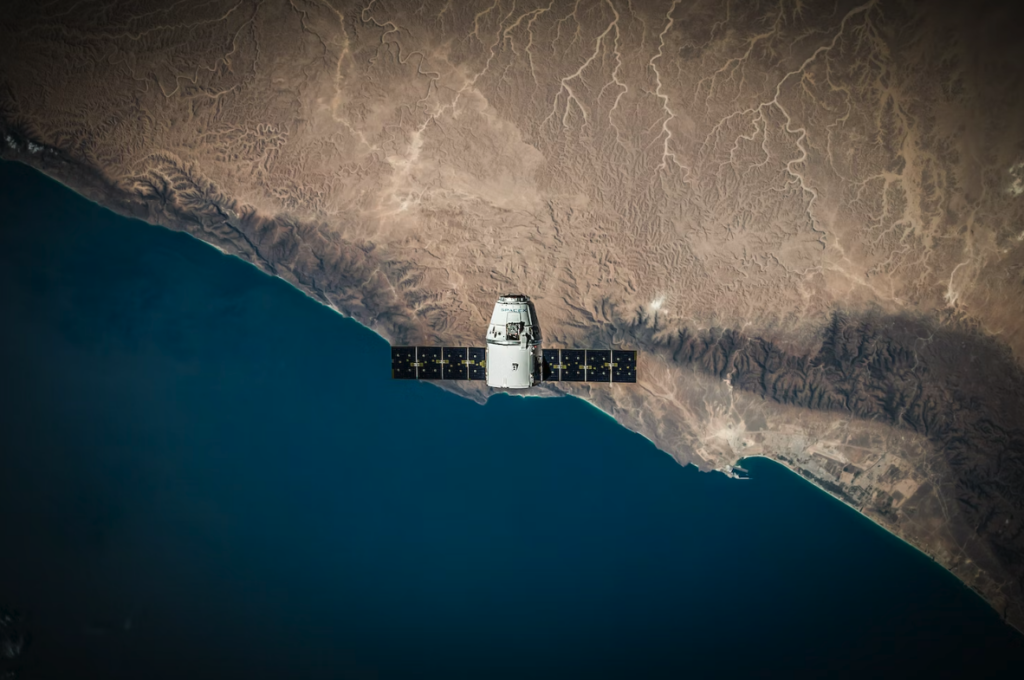Can You See Satellites from Earth?
It’s easy to see satellites from the Earth without a telescope. They are within our galaxy, so it’s pretty simple! Plan and have a specific sighting location, or walk into your backyard and look to the nighttime skies. In either case, you can succeed if you follow a few simple recommendations.
Table of Contents

Which Satellites Can I See?
Can you see satellites from Earth without a telescope? Absolutely! Night time is fast approaching, and you’re ready to spend your time outdoors satellite gazing. We understand. Here’s a quick summary of the satellites that may be available for viewing in your area tonight.
- International Space Station
- Hubble Space Telescope
- Tiangong Space Laboratory
- Space X Dragon capsule
- Starlink Satellite train
How many satellites circle the Earth?
Approximately 8,261 satellites circle the Earth, according to United Nations Office for Outer Space Affairs (UNOOSA.) About 4,852 of those satellites are “active.” Different Astronomy publications provide differing figures concerning the number of satellites.
When “space junk” is added to the equation, estimates place the number of artificial objects that circle the Earth closer to 30,000.
The number of satellites in low earth orbit (LEO) is exponentially increasing. Between 58,00 and 100,000 satellites will be in orbit by 2030. It’s a far cry from the single Russian satellite circling the globe in 1957!
SpaceX, OneWeb, Amazon, and StarNet/GW plan to launch another 65,000 satellites into low earth orbit in the coming years. Rwanda has begun work on a mega-constellation of 320,000 satellites. The night sky is becoming exponentially busier with each passing year.

Satellite or Airplane?
Airplanes have a lot of exterior lights, and it’s easy to confuse them with a satellite.
- Red and green lights on the wingtips allow other airplanes to discern if they’re seeing the right or left side of a plane. (The same as boats!)
- Flashing red beacons on the top and bottom of the plane
- Wingtip white strobe lights flash or blink to help avoid a collision with another airborne aircraft.
The highest probability is that you’ll see aircraft white wingtip strobe lights from the ground and mistake them for a satellite. Not to worry, you’ll soon easily discern between satellites and airplanes with a bit of practice.
- Satellites don’t leave contrails across the skies, but planes do.
- Satellites don’t consistently blink on and off. The bright reflectance of the satellite is relatively consistent as the satellite travels across the skyline.
Insider tip: The intensity of a satellite’s brightness may increase and decrease as it travels across the nighttime sky. The satellite turning or rotating may cause more or less of the satellite’s reflective surface to catch sunlight and reflect it. When we “see” a satellite, we see sunlight reflected off the satellite.

How do I Locate Satellites Without a Telescope?
- The time of day is critical. An hour before dawn or right after dusk are the ideal times to see a satellite without a telescope. Can you see satellites from Earth at night? Yes! You’ll be able to see them when the sun passes below the horizon, but the satellites remain in direct sunlight because of the satellite’s height above the Earth. (Think in terms of sunset when you’re at the bottom of a mountain versus standing at the mountain peak.)
- When the sunlight doesn’t reach the satellites, they’re difficult to spot without a telescope from Earth. Satellites still cross the sky later at night, but you’ll need a telescope to see them.
- Time of year. The northern summer is the best option. Sunlight will still reach the satellite enough to illuminate it a bit during the night hours.
- Weather plays a part too.
- Too many clouds will block the view of the nighttime sky. It’s ok if there are clouds, just not clouds in the location where the satellite will travel across the skies!
- Trying to view satellites with shallow angles to the horizon. The greater the satellite height is above the horizon, the easier it will be to detect.
- Extreme heat causes the air’s refractive index to oscillate. The oscillations cause the air to look “wavy” or “shimmering.” Very applicable when the satellite has a shallow angle to the Earth.
- Minimize light pollution. Go somewhere that’s really “dark!” Light pollution is the bane of astronomy. Even driving to a city park, away from bright lights, is a big help for nighttime satellite detection. Avoid white light to allow your eyes to acclimate to the darkness.
- Bigger is better! The larger the satellite, the more reflective the surface it contains. More reflective surfaces on the satellite equate to the object being “brighter” in the sky and easier to detect.
Size Matters-What Satellite Should You Try to Locate?
We recommend starting your search with the largest satellite and working “down” in size.
- The International Space Station (ISS) is the size of an American football field. The ISS is the largest manufactured object in the nighttime skies. Depending upon the conditions, the ISS may be brighter than Venus.
- Starlink satellites and their extended solar panels are the combined size of three yellow school buses parked side by side. “Starlink Satellite trains” are highly visible for several days following their launch without a telescope. The satellites are increasingly difficult to detect with the naked eye as they move further away from Earth.
- The Hubble Space telescope is approximately the size of a semi-truck, with two cars parked on each side of the semi representing the solar panels. NASA specifies several conditions that need to be met to spot the Hubble from Earth.
- Passes “closely enough overhead.”
- Relatively dark
- Skies are clear
- Tiangong space laboratory is approximately half the length of an American football field. The Tiangong space laboratory is approximately 1/5th the size of the International Space station, so its brightness isn’t as intense as the ISS. It’s still visible from the Earth without a telescope!

Preparation! Do Your Homework!
You can see satellites from Earth, it just takes planning! Preparation is critical to maximizing the probability of satellite spotting from Earth without a telescope. We like the spontaneity of walking into our backyard with a cold drink and a lawn chair. (Sometimes it even works!)
We recommend using a website or a phone app to help locate a specific satellite. Viewing time is abundant when looking at the moon, stars, or planets. Satellite viewing times may be very brief. A Satellite may pass through the entire skyline in less than four minutes. It’s all about the height of the satellite above the horizon.
A cell phone application or website will help you determine when you’ll have the best odds of viewing success.
Conclusion
The answer to our question can you see satellites from Earth is not only simple, but exciting because we don’t need complex equipment to see satellites from Earth. We need the willingness to sit in our backyard and observe the nighttime skies with our own eyes. No amount of technology will increase the wonder of what we see.
